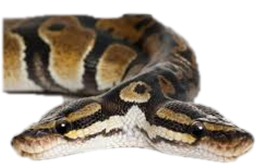FACTS ON SNAKE
FACTS ON SNAKES
- v Snakes do not have eyelids. They do have an eye ‘spectacle’ which protect
their eye. This ‘spectacle’ comes away when a snake shed its skin.
- v Two-headed snakes are similar to
conjoined twins: an embryo begins to split to create identical twins, but the
process does not finish. Such snakes rarely survive in the wild because the two
heads have duplicate senses, they fight over food, and one head may try to eat
the other head.
- v A mysterious, new “mad snake disease”
causes captive pythons and boas to tie themselves in knots. Other symptoms
include “stargazing,” which is when snakes stare upwards for long periods of
time. Snake experts believe a rodent virus causes the fatal disease.
- v The largest snake fossil ever found is the Titanoboa. It lived over 60
million years ago and reached over 50 feet (15 meters) long. It weighed more
than 20 people and ate crocodiles and giant tortoises.
- v Although a snake’s growth rate slows
as it gets older, a snake never stops growing.
- v The black mamba is the world’s
fastest snake and the world’s second-longest venomous snake in the world, after
the king cobra.
- v Anacondas can hold their breath for
up to 10 minutes under water. Additionally, similar to crocodiles, anacondas
have eyes and nostrils that can poke above the water’s surface to increase
their stealth and hunting prowess.
- v If the temperature reaches below 50°
Fahrenheit, a snake’s body does not work properly.
- v Snakes are NOT aggressive. They are
shy secretive animals. Snakes do not bite out of malice, and they certainly do
not go looking for enemies. They will defend their lives if/when needed. Snakes
DO like to be left alone.
- v Of the approximately 725 species of
venomous snakes worldwide, 250 can kill a human with one bite.
- v Snakes evolved from a four-legged reptilian ancestor—most likely a small,
burrowing, land-bound lizard—about 100 million years ago. Some snakes, such as
pythons and boas, still have traces of back legs.
- v The top 5 most venomous snakes in the
world are the inland taipan, the eastern brown snake, the coastal taipan, the
tiger snake, and the black tiger snake.
- v Pythons do not have fangs like venomous snakes. They have up to 80 small
needle sharp recurved (slope backwards) teeth. They have one two rows either
side on the bottom and top jaw – PLUS an extra two rows in the middle of the
top jaw.
- v Snakes are found on every continent
in the world except Antarctica.
- v Snakes have smooth dry skin that is
covered in scales. These scales are made of Keratin.
- v The death adder has the fastest
strike of any snake in the world. It can attack, inject venom, and go back to
striking position in under 0.15 seconds.
- v The word “snake” is from the
Proto-Indo-European root *sneg-, meaning “to crawl, creeping thing.”
- v There are about 500 genera and 3,000
different species of snakes. All of them are predators.
- v There are five recognized species of flying snakes. Growing up to 4 feet,
some types can glide up to 330 feet through the air.
- v Snakes often represent the duality of
good and evil and of life and death.
- v Snakes have a very acute sense of smell and taste – they use their forked tongue to pick up scents.
with love and passion for science,
Devmitra.V







Comments
Post a Comment